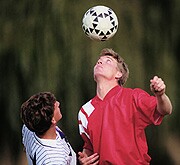- Navigating Your Midlife Crisis: Embracing New Possibilities
- City Raccoons Showing Signs of Domestication
- Mapping the Exposome: Science Broadens Focus to Environmental Disease Triggers
- One Week Less on Social Media Linked to Better Mental Health
- Your Brain Changes in Stages as You Age, Study Finds
- Some Suicide Victims Show No Typical Warning Signs, Study Finds
- ByHeart Formula Faces Lawsuits After Babies Sickened With Botulism
- Switch to Vegan Diet Could Cut Your Greenhouse Gas Emissions in Half
- Regular Bedtime Does Wonders for Blood Pressure
- Dining Alone Could Mean Worse Nutrition for Seniors
Banning Soccer ‘Headers’ Won’t Solve Concussion Problem: Study


While many experts have called for a ban on “heading” the ball in youth soccer because they believe it is a leading cause of concussions, a new study suggests the body contact that often occurs during such play is to blame for most brain injuries.
So banning headers among high school players would not reduce concussion rates as much as enforcing existing rules on rough play would, the researchers added.
Heading the ball “is very much at the heart of soccer culture,” explained study author R. Dawn Comstock, a faculty member in the department of epidemiology with the Colorado School of Public Health at the University of Colorado in Aurora. “And, yes, we found that heading is the activity in soccer during which most concussions occur among both boys and girls,” she added.
“But if you look closely, it’s not generally the impact of the ball to the head that leads to concussion. The vast majority of the time it’s the athlete-to-athlete contact that happens during [heading] that causes the concussion. One player’s head hitting another player’s head, or a shoulder-to-head [collision]. That’s the problem. Not the ball,” Comstock explained.
“So, yes, if you eliminate heading in soccer you would definitely reduce concussions,” Comstock acknowledged. “But soccer is not actually a full-contact sport. And there are rules of the game that already exist that penalize the kind of dangerous out-of-position contested heading that results in athlete-to-athlete contact.”
So, she suggested, “if you just enforce these rules you would dramatically reduce aggressive body contact, and dramatically lower the concussion rate, without having to change the culture of the sport by eliminating heading itself.”
The findings are published in the July 13 online edition of the journal JAMA Pediatrics.
Soccer’s popularity among U.S. high school students has grown enormously in recent years. Today, almost 800,000 teens play the sport in the United States, compared with the mere 50,000 (exclusively male) students who played back in 1970, according to the report.
An analysis of data collected between 2005 and 2014 showed that today, girls actually face a higher risk for soccer concussions than boys: 4.5 concussions for every 10,000 practice or game exposures, compared with just 2.8 concussions per 10,000 exposures among boys.
Heading is the most concussion-prone activity, accounting for more than 30 percent of all concussions among boys, and more than 25 percent among girls, the investigators reported.
However, 78 percent and 62 percent of heading-related concussions among boys and girls, respectively, were attributed to body-on-body contact between players, rather than head contact with the ball, the study said.
“Based on this evidence, I would say that if soccer officials are going to allow the sport to become increasingly aggressive then, yes, please ban heading,” said Comstock. “But be clear that what’s causing concussions is not the ball. It’s athlete contact.”
But Robert Stern, a professor of neurology, and neurosurgery and anatomy and neurobiology at Boston University School of Medicine, argued that the current study “really misses the point.”
“I’m a soccer fan and a major supporter of youth athletics of all different types,” he said. “And we must keep in mind the incredible benefits of youth sports, including sports that result in a lot of injuries. But I do completely support those who want to eliminate heading in soccer at a young age, because the intense focus we’ve been having on the so-called ‘concussion crisis’ in recent years misses the much bigger issue: What happens to brains when they are exposed to repetitive hits to the head?” Stern said.
“I don’t expect there to be a lot of concussions caused directly by heading a ball,” stressed Stern, who also serves as the clinical core director of the university’s Alzheimer’s disease and CTE Center.
“But I’m talking about all the long-term consequences that come from ‘sub-concussive’ hits, absent any concussive symptoms. The repetitive brain trauma that comes with hitting the ball frequently with the head, causing changes to the white matter integrity of the brain, cognitive [mental] changes, and other alterations to brain functioning,” he explained.
“And I would say that parents who struggle with trying to understand this issue need to ask one very important question: Does it make sense for us to allow for our young kids to participate in an activity that results in repetitive brain trauma?” he said. “Personally, I think children deserve to have adults protect their developing brains.”
More information
There’s more on brain injury and sports at the U.S. Centers for Disease Control and Prevention.
Source: HealthDay
Copyright © 2025 HealthDay. All rights reserved.










